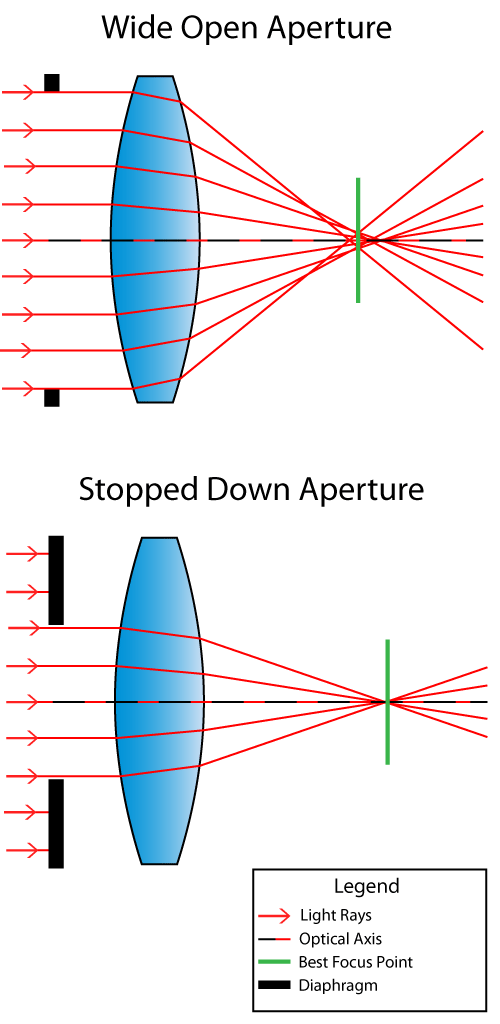 Originally posted by pschlute
Originally posted by pschlute 
You must not allow the camera to refocus at all if you are trying to diagnose focus shift. To do so would defeat the object of the test
Your proposed method will still not deal with the issue of dof distribution
Why do you suspect focus shift may be an issue ?
If you watch the video, the chap is basically suggesting that Focus Shift is part of the optical design of a vast majority of lenses for many brands, I think he said that Macro lenses tend to suffer least due to floating parts or something. I felt he was alluding to the fact that 'Focus Shift' was seldom talked about, and for me I have been shooting only a couple of years but felt I had stumbled onto something that might account for my own personal frustrations with PDAF, in that calibrating for wide open might not be the same values for further stopped down (even slightly so such as f3.5 etc).
When he showed his 'focus chart' (or rather that line of text) and the front/back focusing issue to show how things progressively get worse the more he stops down, I thought perhaps this accounted for quite a few oof shots and perhaps also accounted for some lenses that receive mixed reviews in terms of Sharpness etc (perhaps a lens appears sharp to someone who has calibrated it (FA) for wide open (and shoots it primarily wide open), but another user with the same lens gets varying sharp shots or ranks the Auto Focus as bad if those shots come out looking soft a lot of the time (because they actually shoot whilst applying a varying degree of different apertures rather than sticking more or less with a wide open approach).
So it's not that I thought I was suffering Focus Shift per se, but rather perhaps all this time I have FA my lenses for wide open, and that I should also check if I felt the FA value was still good for when shooting stopped down (like f4-5.6 etc). If the value was significantly different then that might account for some of those 'eyebrow' shots I have plenty of in my archive

I did think it was interesting how when using a Focus Chart, and although using PDAF and refocusing each time, from f1.8>f8 it felt I benefited from FA curve that increased as I stopped down, and that with the Macro lens really things were pretty consistent, +1 difference, if needed at all (which I guess I thought added more fuel to the fire of his opinion that Focus Shift is wide spread, and that Macros suffer less).
Today later on I shall repeat the test, this time take notes and upload images. "Oh joy!" says everyone!

 Originally posted by CarlJF
Originally posted by CarlJF 
Lets not forget that we work with photography equipment, not some kind of high precision astronomical or scientific devices. So, yes, there is some variation and they are normal and expected. Although there can be focus shift when closing the aperture, in practice this doesn't matter for photography. Because the increase in DOF will more than cancel any slight shift the focus may have (unless the lens is defective, which is totally different matter). So, basically, just enter the adjustment for the widest aperture and don't overthink or overwork it, unless doing it as some kind of scientific experiment. It should work good enough for more than 99% of photography needs.
If you need extremely accurate focusing, the best is still to work in manual focus. No matter how far you go in defining precise adjustment, autofocus will still be less accurate for fundamental reasons.
And this is something I didn't factor in really when doing my testing. I noted that the more I stopped down with the FA77, I seemed to benefit from adding a few FA points, but afterwards, shooting a bottle on the wall in the garden, really at f5.6-8 I could have +8 or 0 for FA and the bottle stayed sharp throughout lol.
I guess this Focus Shift thing, if a real thing to contend with should be something you care about only from perhaps f1.4-f3.5 etc
 Originally posted by stevebrot
Originally posted by stevebrot 
Optical evaluation for focus shift requires accurate and precise fine focus technique. That is why live view is used; it is the gold standard. Using PDAF fine adjust to evaluate focus shift just adds another set of variables. My opinion (based on reads of over a hundred threads on AF fine adjust) is that most people over-adjust or adjust based on spurious or inadequate data. That is why I added the qualifier that use of one of the available focus evaluation software packages might be in order when trying to detect subtle focus shift, even with manual focus under live view.* That being said and out of the way, a +8 adjust from wide open is anything but subtle. I did not see that kind of shift with my lens. My unsolicited advice is to redo using live view.
FWIW, focus shift results from uncorrected spherical aberration and is most evident at close distances. While once not unusual and part of the lore of measurebating film photographers when I was young, it was usually not an issue under field conditions. Ansel Adams covers the subject in the 1980 edition of "The Camera" with suggestions for refocus stopped down if there is any doubt. His solution was in regards to a particular class of large format lenses and involved refocus on specular reflections using a magnifying loupe on the view camera ground glass; think of it as magnified live view. Focus shift used to be part of photo magazine lens tests, but as optics improved, that aspect of testing was dropped. Now days, the term is more frequently applied to focus stacking with Nikon than to lens aberrations. Significant focus shift is more of a novelty of the past than a serious and ongoing concern.
Roger Cicala dedicates two paragraphs of his article on using fast lenses to the subject. His short discussion is concise and to the point. In fact, the whole article is excellent for putting the "must have fast primes" discussion in perspective and may shed light on why many of the experienced (older) users on this site take a fairly dim view of the current call for ultra-fast wide angles and such.
Lens Rentals | How to Shoot With Wide Aperture Lenses
Steve
* I have seen example scattergrams from PDAF evaluation and they are fairly alarming. PDAF, while quite adequate, remains a fairly blunt tool for fine focus.
Ok I have a few questions about this post;
1) I wasn't using Fine Adjust to evaluate Focus Shift, I would use it to compensate for any Focus Shift I saw from having none applied. Basically I was doing a typical focus chart test, set things up, at first doing wide open (f1.8), taking multiple shots getting the camera to refocus each time with no FA applied yet. Review the results, typically go to the half way point (+5), take more shots, review, adjust as necessary etc, and that's how I determined I get sharper images at +3 for f1.8. I did the exact same thing at f2.8, f4 and 5.6 and f8. I didn't have the +3 or +5 or whatever applied during testing until I felt after reviewing that adjustments applied helped get focus more centred. Had I left all my FA off and shown the images then how my focus chart looked might have looked similar to the chaps video 'chart' (lines of text).
2) I was under the impression all Focus Charts and any FA applied were to be done in PDAF mode, that is in actual fact doing it in Live View mode negates it all as LV doesn't actually USE FA values when taking the shot at all?! Am I incorrect here? I thought FA values only applied to PDAF, LV is Contrast detection and as such doesn't use FA values. If I'm wrong then this video makes more sense as he's always demonstrating his 'focus charts' in LV mode, I just thought he was illustrating visually what to do for the video, but kinda took it for granted without saying anything that you would do the real testing through the OVF...
3) My wide open f1.8 value in PDAF is +3, +8 would indeed be horrid results. +8 is the FA value I felt helped get things more centred focus wise when doing the Focus Chart at f8. This was the first time I had tried a Focus Chart at anything other than wide open, as the DoF increases I found it increasingly hard to evaluate if things were more soft above the centre or below. With wide open it's way easier isn't it, the DoF is so thin you can see if things are soft just a few mm above the focus line, with f5.6 and f8 I was having to scan far up and down the chart, to the numbers marked 8, 9 and 10 etc and judge if I felt those numbers looked 'equally' soft etc. It was after multiple shots with FA at 0, and then repeating with FA at +5, and then repeating at +10, and then repeating +8 that I decided the +8 shots looked like the focus chart looked the most balanced in terms of ONLY where the outer chart numbers looked equally blurry. In reality the centre focus line was deadly sharp throughout.
So then, what do we make of this guys video? Does he just like weirdly badly Focus Shifting lenses?
I still don't understand how focus shift can exist at all, in so much if the focus is obtained 'wide open' and then the aperture only closes down for a split secong, why would things focus differently? Focus has already been obtained at f1.8 (for the FA77), taken at f5.6 is a blink of an eye...

I mean I guess if the aperture shutter closes/stops down for the AutoFocus part, but it doesn't :|
He seems to think a FA value that adjusts with the aperture makes sense and is shocked it's not something widespread. So... is he just wrong?


 Similar Threads
Similar Threads 















 Post #17 by stevebrot
Post #17 by stevebrot








